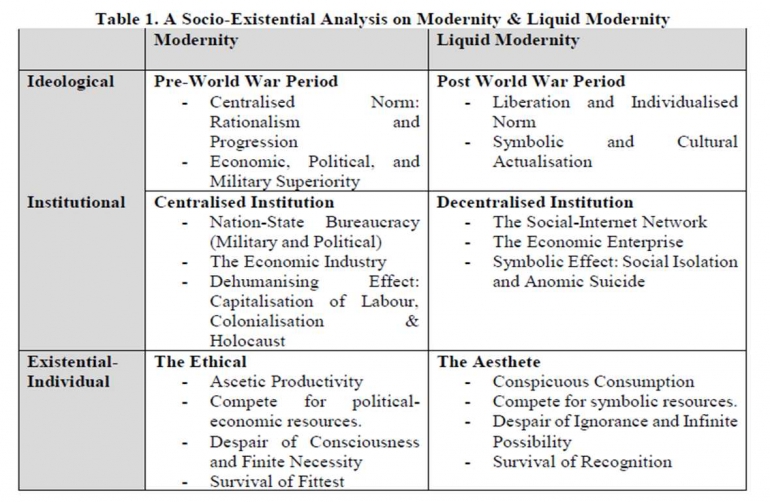Liquid modernity and the aesthete’s despair
After the World War period, various philosophical reflection arises to answer the problem modernity. The question is no longer about modernity but against it: “If the modern project ends up in violent militarism, what is the alternative project that is available?” While some suggest that Postmodernity - the rejection of any fixed project is the utopian alternative, in reality Postmodernity is not fully exercised: the growth of industries and basic bureaucracy are still necessary to maintain progression in the midst of global socio-economic competition, in fact economic industries have evolved rapidly causing unprecedented economic growth in the West. The position of the current Western society is not fixed modernity nor anomic Postmodern, it does not fall into the either extremes but is positioned in between the spectrum. Bauman named this phenomenon as Liquid Modernity as it is the new mode of contemporary social life which suggest a “more flexible form of modernity”. The author tends to lean towards Bauman’s view on the current society as it is experiencing an atmosphere of “greater freedom (not total freedom)” in the globalised network society.
The apparent ideological worldview in the social mode of Liquid Modernity is Liberation and Consumerism. If modernity is born as a protest towards the State-Church, liquid modernity is a protest towards modernity. In each historical transition, there is a counter reaction towards the social structure whereby each stage claims that they ought to be liberated from the previous societal mode. In each stage, each mode suggests a certain form of project: If modernity puts rationalism and progression as its utopian destination, liquid modernity places individualised liberation and production of opportunities as its new primary objective (Bauman, 2000:62). In this post-industrial scenario, the political sphere no longer holds obligative demands upon the citizens, the economic sphere instead has the stronger role to comply towards the individuals’ needs.
The character of institutions has also evolved into a more “liquified state”. Unlike modernity, the liberating nature of social institutions has caused the privatisation of values; individuals are not made for institutions, but social institutions are now made for the individuals’. Security is no longer the obligatory objective aimed by institutions, they have been opened up towards the fulfillment of desire. Individuals no longer hold a communal interest for each person is “at one’s own centre of issue” (Gane, 2001). It is very likely that social institutions were adjusted to please and meet the desires of the consumers. Therefore, bureaucracy and economic industries that were known as iron cage “solids” and requires machine-like discipline violates the idea of individual liberation (Scaff, 1987). Those solid institutions have been replaced by liquid social institutions such as social network (internet) and economic enterprises (malls) which opens up the vast sea of choices and possibilities. Liquid modernity opens the room for the fertile growth of creative industries and innovative products and discoveries. And yet, the liberation that such modernity provides constitutes the consumptive society - the social atmosphere that consumers were continually seduced by concrete commodities and abstract signs to self-actualise, attain social status and affection (Braudillard, 2001; Hardt, 1999).
However, liquid modernity does not end in the liberation of individuals to consume signs attached to concrete enterprised goods. In this mode of social living, individuals have replaced the quality of social relation into quantities of networks and uncommitted relationships (Bauman, 2003). The ideological nature of liberation mutates further to the most abstract form of privatised institutions, namely social network (The Internet). Signs are not only narrowed to the purchase of commodities in the shopping malls, the human person is commodified into visual signs (digital personas), infinitely distributed and consumed across space and time in the internet. It is through this method whereby ordinary individuals surrender their inner private lives to be commodities of seduction in the strata of popularity. Through the use of social media, ordinary individuals reconstruct themselves into a digitalised self, imitating the celebrity persona, and also to add or delete the digital other in the process of consummption.
In the existential sense, the era of consumerism and seductive possibilities suggest the aesthete mode of existence (Gary, 2016). The aesthete is understood as one who has no self, ignorant of one’s authentic existence as one who depends on the consumption of external commodities to define the self. Liquid modernity has induced the knowledge that the individual is liberated to consume every possibility which satisfy the desire, and yet it is precisely in the uncontrolled production of infinite chances, that the self experience continual anxiety. The ethicist in this case experience the despair of ignorance that one does not have an independent self as the identity is continually shapeshifted by signs displayed by the economic enterprise and internet.
The despair which the liquid individual experience is lack of finitude and necessity. This form of despair shows that in the individual do not have a matured selfhood, one is fantasised and defined by signs (Evans, 2004: 45-46; Lazaratto, 2004). Signs are the symbolic status which the individual derives from what he or she consumes to signify social identity. If modernity produces robotic individuals, then liquid modernity produces liquid individuals. These individuals do not remain in a relatively fixed identity, one is constantly searching, and consuming external factors which define one’s identity. The individual will always be updated, decorated, and malleable with the unpredictable waves of trend. With the infinite possibilities continually produced by social institutions, the self lives in the fantastical realm of signs (Kierkegaard, 1980: 30-37, 42-47). However, it is precisely in this notion that the individual is in constant state of anxiety and restlessness as one could easily be left behind and disappear if he or she is incapable to appear in new signs.
Furthermore, as the person of immediacy lives in connection with infinite personas, one is in constant audition to imitate “the popular other”, and to please digital consumers – this is the logic of “follow and following. And yet because the individual is tangled in a huge network, the individual is perceived as “isolated dot” in the vast globalised network - ready to be overwritten by new trends, disappear from the scene of digital crowd. Thus, in liquid modernity although the Aesthete may emotionally feel the ecstasy of symbolic satisfaction, however if the mood is not maintained along the continual rise of seduction, the cold boredom and depression would arrive and brings the isolated individuals into suicide as a new form of “holocaust”: whereby fear and insensitivity and loneliness will become the end means of liquid modernity (Bauman & Donskis, 2013: 94-132). With the growing use of technological innovations, creative marketing (advertisements), and social medias, the current society contains such familiar knowledge of liberation and anxiety.
Man’s search for authenticity
As we return to Kierkegaard’s philosophical framework, we find that in each societal mode of knowledge, the individual lives in a mode of existence and is contingent to certain form despair. The difference in societal knowledge does not allow the individual to be completely free from the circle of despair. In the contrary, the movement from modernity to liquid modernity shows the “deconstruction of norms” and pulls the individual back from the Ethical to the Aesthete stage of existence. Although it is not valid that all society in the Western hemisphere is moving in the state of liquidity, nevertheless this trend shows that societal norms of progression in the Western region (Europe and America) is being reinterpreted or overwritten by consumptive lifestyle. It is quite interesting to note that as several societies tends to be “ethical” to achieve higher level of socio-economic welfare by conforming to the knowledge of progress, at the midpoint of the linear historical journey, those societies tend to move backward to the “aesthete” to enjoy the welfare it has accumulated.
Thus, the question for man’s existential authenticity is still a challenge to be debated, particularly as we are shifting back and forth in the pendulum of solid modernity and liquid modernity, between the Ethical and the Aesthete. Kierkegaard proposed that man’s authenticity is neither located in the Aesthete nor Ethical mode of existence nor the synthesis of both stages, but rather in his search in the authentic of I-Eternal Thou relation. This is not very different from Sorokin’s arguments that the Actual mentality also includes the role of religion as they are the most enduring form of knowledge that has been transmitted throughout history, providing the metaphysical and existential options for human existence.








